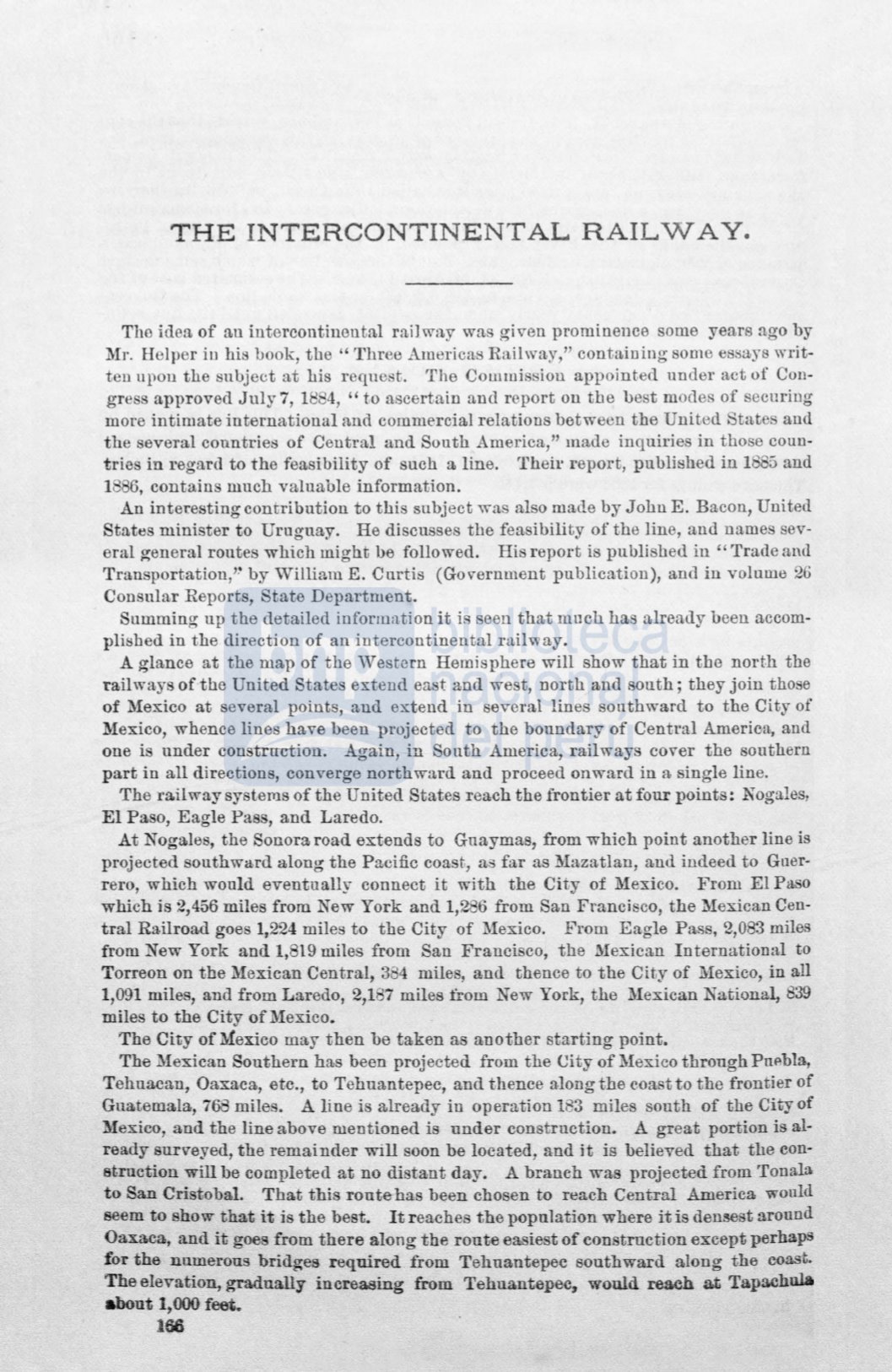

THE INTERCONTINENTAL RAILW
A
Y.
Tbo idea of an intercontinental raiJway wn,s given prominence sorne years ago by
Mr. Helper iu bis book, the '' Three Americas Railway," containing sorne essays writ–
ten upon the subject at bis reqnest. The Commission appointed nnder act of Con–
gre s approved July7,
1884,
"to ascertain and report on the best modes of securing
more intimate international and commercial relations between tbe United States and
the several countries of Central and South America," made inquiries in tbose coun–
tries in regard
to
the feasibility of such a line. Tbeir report, publisbed in
1885
and
1 86,
contains much valuable information.
An interesting contribution to this snbject was also made by John E. Bacon, United
States minister to Uruguay. He discusses the feasibility ofthe line, and names sev–
era! general routes which might be followed. His report is publisbed in "Trade and
Transportatiou,'~
by Williarn E . Curtís (Government publication), and in volume
26
Consular Reports, State Department.
Summing up the detailed information it is seen that much has already been accom–
plisbed in tbe direction of an intercontinental railway.
A
glance at the map of the Western Hemisphere will show that
in
tbe north the
railways of the United States extend east and west, north and south; they join tbose
of Mexico at several points, and extend in severa! lines southward to tbe City of
Mexico, wbence lines have been projected to the boundary of Central America, and
one is under constrrrution. Again, in South A.merica, railways cover tbe southern
part in all directions, converge northw::trd and proceed onward in a single line.
Tbe railway systeros of tbe United States reach tbe frontier at fonr points : Nogales,
El Paso, Eagle Pass, and Laredo.
At Nogales, the Sonora road extends to Guaymas, from which point another line is
projected southward along the Pacific coast,, as far as Mazatlan, and indeed
to
Guer–
rero, which would eventually connect it with the City of Mexico. From El Paso
which is
2,456
miles from New York and
1,286
from San Francisco, the Mexican Cen–
tral Ra.ilroad goes
1,224
miles to tbe City
of
Mexico. From Eagle Pass,
2,083
miles
from New York and
1,819
miles from San Francisco, the .M:e:xican International to
Torreon on tbe Mexican Central,
384
miles, and thence to the City of Mexico, in all
1,091
miles, and from Laredo,
2,1 7
miles from New York, the Mexican National,
839
miles to the City ofMexico.
Tbe City of :M:exico roay then be taken as anotber starting point.
Tbe Mexican Soutbern has been projected from the City of Mexico througb PMbla,
Tehnacan, Oaxaca, etc., to Tehuantepec, aud thence along the coa-st to tbe frontier of
Guatemala,
768
miles.
A
line is already in operation
1 3
miles south of the City of
Mexico, and the line above mentioned is under construction.
A
great portion is
al–
ready snrveyed, the remainder will soon be located, and it is believed that
the
con–
str uction will be completad at no distant day.
A
branch was projected from Tonala
toSan CristobaL That this rontehas been chosen to reach Central America would
seem
to
sh ow that
it
is the best. I t reacbes the popnlation where it is densest aronnd
Oaxaca, and
it
goes from there along tbe ron
te
easiest of construction except perhaps
for the n umerous bridges reqnired from Tehnantepec southward along the coast.
The elevation, gradnally increasing from Tehuantepec, wonld reach
a.t
Tapachula
a bont 1,000
feet.
166
















